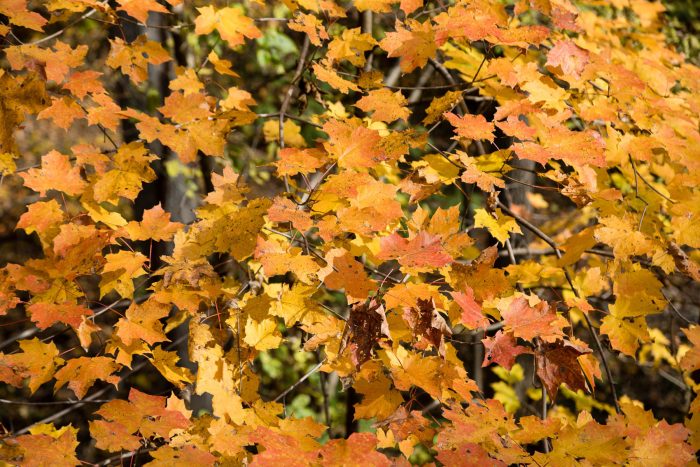Sugar Maple
Acer saccharum
The sugar maple is a deciduous hardwood tree with pointed lobed leaves. It can be found throughout the Chesapeake watershed.
This section shows one large critter image at a time. Use the thumbnails that follow to select a specific image to display here.

This gallery contains a grid of small thumbnails. Selecting a thumbnail will change the main image in the preceding section.
Appearance
The sugar maple has leaves with five pointed lobes. The leaves are green with a paler underside and turn red, orange or yellow in the fall. It has yellow-green drooping flowers and helicopter seeds about an inch in length.
The gray bark of the tree is furrowed and becomes darker and shaggier as the tree gets older. It can grow to more than 70 feet in height with a spread of 40 to 50 feet.
Predators
Various parts of the tree are eaten by deer, squirrels and porcupines.
Reproduction and life cycle
Sugar maples don’t reach seed-bearing age until they are 30 to 40 years old. The trees produce yellow-green flowers sometime between April and June. The fruit is a winged nutlet, or the helicopter type—two connected winged seeds that spin through the air—and ripens between June and October. Though the seeds are produced every year, seed production peaks every two to five years.
Did you know?
- The sugar maple is the state tree of New York and West Virginia.
- Sugar maples are the best trees for making maple syrup, as their sap contains twice as much sugar as other maple species.
- Sugar maple trees do not do well as a street tree, since it is intolerant of high heat and air pollution, but can do well in backyards.
- Even low-range predictions from the U.S. Forest Service’s Climate Change Atlas suggest habitat for sugar maples will retreat to the northern reaches of the watershed over the next 100 years as our climate changes and temperatures rise.
- Various parts of the tree are eaten by deer, squirrels and porcupines.
Sources and additional information
- Plant Guide: Sugar Maple – United States Department of Agriculture
- Tree Guide: Sugar Maple Tree – Arbor Day Foundation
- DePauw Nature Park Field Guide: Sugar Maple – DePauw University
